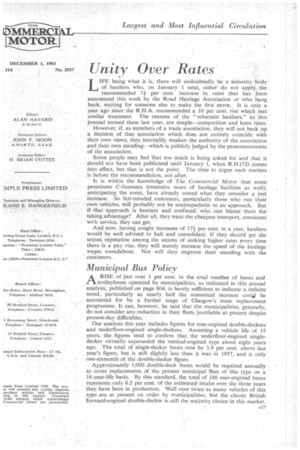Unity Over Rates
Page 29

If you've noticed an error in this article please click here to report it so we can fix it.
LIFE being what it is, there will undoUbtedly be a minority bodyof hauliers who, on January 1 next, either do not apply the recommended 71 per cent. increase in rates that has been-announced this week by the Road Haulage Association or who hang back, waiting for someone else to make the first move. It is only a year ago since the R.H.A. recommended a 10 per cent. rise which met similar treatment. The reasons of the "reluctant hauliers," as this journal termed them last year, are simple—competition and keen rates.
However, if, as members of a trade association, they will not back up a decision of that association which does not entirely coincide with their own views, they inevitably weaken the authority of the association and their own standing—which is publicly judged by the pronouncements of the association.
Some people may feel that too much is being asked for and that it should not have been publicized until January 1, when R.H.(72) comes into effect, but that is not the point. The time to argue such matters is before the recommendation, not after.
It is within the knowledge of The Commercial Motor that some prominent C-licensees (extensive users of haulage facilities as well), anticipating the event, have already costed what they consider a just increase. So fair-minded customers, particularly those who run their own vehicles, will probably not be unsympathetic to an approach. But if that approach is hesitant and confused, who can blame them for taking advantage? After all, they want the cheapest transport, consistent with service, they can get.
And now, having sought increases of 171 per cent. in a year, hauliers would be well advised to halt and consolidate. If they should get the unjust reputation among the unions of seeking higher rates every time there is a pay rise, they will Merely increase the speed of the haulage wages roundabout. Nor will they improve their standing with the customers..
Municipal Bus Poltcy
ARISE of just over 1 per cent. in the total nuntber of buses and rolleybuses operated by municipalities, as indicated in this annual analysis, published on page 604, is barely sufficient to indicate a definite trend, particularly as nearly half the numerical increase coulil be accounted for by a further stage of Glasgow's tram replacement programme. It can, however, be said that the municipalities, generally, do not consider any reduction in their fleets justifiable at present despite present-day difficulties.
Our analysis this year includes figures for rear-engined double-deckers and underfloor-engined single-deckers. Assuming a vehicle life of 15 years, the figures tend to confirm that the underfloor-engined singledecker virtually superseded the vertical-engined type about eight years ago. The total of single-decker buses rose by 3.9 per cent. above last year's figure, but is still slightly less than it was in 1957, and is only one-sixteenth of the double-decker figure.
Approximately 1,000 double-deck buses would be required annually to cover replacements of the present municipal fleet of this type on a 16-year-life basis. By this standard, the total of 186 rear-engined buses represents only 6.2 per cent, of the estimated intake over the three years they have been in production. Well over twice as many vehicles of this type are at present on order by municipalities, but the classic British forward-engined double-decker is still the majority choice in this market.
































































































































